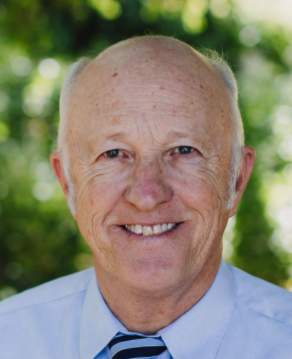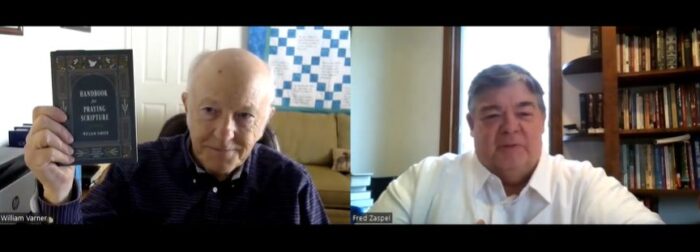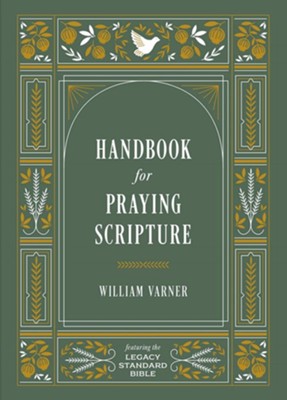An Author Interview from Books At a Glance
Would you like to watch the video interview or listen to the audio? Sign-up today for access to these features and more.
Greetings, I’m Fred Zaspel, and welcome to another Author Interview here at Books At a Glance. Today we’re talking to Dr. Will Varner about his new book, Handbook for Praying Scripture.
Will, welcome back to Books At a Glance!
Varner:
Fred, it is always a delight to be with you. Thank you for the opportunity of explaining what my book is about.
Zaspel:
First, tell us just briefly what this book is, how it came about, and what contribution you hope to make with it.
Varner:
For years I have made an attempt to pray Scripture and sometimes adapt it. Mine is not the first book in this regard. Don Whitney has a book, Praying the Bible. He recommends praying through Scripture, working through a passage, and turning it into prayer. My book is employing specific biblical texts and praying them back to God. Ken Boa has a book, Praying Scripture Back to God. This is my own contribution.
There is a personal thing here that I am happy to say. After my daughter’s death I had found myself in a lack of focus in prayer. My mind was wandering. So, I found that praying a prayer book with set prayers was helpful. I am sure for many of your readers just praying someone else’s prayers in a prayer book is good, but you would like to make it a little more personal. What is better than inspired prayers from the Psalms?
After my daughter’s death I needed help and I began praying Scripture. Last spring, I said, “why don’t I put one of these prayer books together?” I floated it by the publisher, and he liked it. The result is a book of prayers and adapted prayers following a daily schedule for thirty-one days. Then there is a one-week schedule for longer prayers. I try to cover the basic elements to pray.
I always tell my students, “I know you do not have the problem of your mind wandering in prayer, but I have this problem.” Let’s face it, we all have this problem. My prayers turn into “give me, give me.” We all know that prayer is more than that. A lot of us old timers remember the ACTS prayer acronym. The ACTS method incorporates adoration, confession, thanksgiving, and supplication. I have tweaked that some. Not that it is a wrong way, but every day begins with an adoration prayer, then a thanksgiving prayer, then a confession prayer, then an affirmation prayer.
I know Luther said pray the Apostles’ Creed every day to affirm the truth. We have an affirmation there to do that. Then the Lord’s prayer which I call the disciples prayer, is then prayed and that is Scripture. Then I have petition, where I have adapted Scriptures to pray for yourself. Then intercessory prayers to pray for others. Then finally, ending with a benediction. With those seven categories I have gathered Scripture from all over.
Obviously, there is a big section of Psalms. I try to have variety. It is not the same everyday but there is a pattern every day. I am not afraid to use an adoration prayer two or three times in the thirty-one days. So, there is structure but hopefully flexibility. This method worked for me and I am praying that it works for others as well.
Zaspel:
“Praying Scripture” may be a new concept for some, so talk to us about the place of Scripture in prayer.
Varner:
As you and most of your viewers know, many psalms are prayers. If they were good prayers for David and the psalmist, they are good prayers for us. When David sinned and Nathan confronted him and he repented, we believe that as Psalm 51 is titled, it is his prayer of repentance. If I am convicted of sin, I need to pray. What better way of praying is there than an inspired prayer. These inspired prayers are very important.
Sometimes I adapt them, but I am careful in adapting to never change the intent of the prayer. Sometimes Paul will say, “I want you to do this.” I will turn that into a prayer saying, “Lord may I be this or do this.” This is keeping the intent of the Scripture statement but turning it into a prayer. We list the Scripture reference beside each prayer and whenever I have adapted it the publisher has put an asterisk by the reference showing that Varner has adapted this prayer. That is what praying Scripture is all about.
If Scripture can give a benediction than I should give a benediction. If Jesus said, “pray then like this,” in what I call the disciples’ prayer, then I should pray like that. I have been careful to include that Jesus would not have prayed “forgive us” but says it for his disciples to pray. And I leave the title, the Lord’s prayer, for John 17 where he is praying. I include that every day. The Didache, one of the early church manuals, says to pray the Lord’s prayer three times a day. I put it in once a day. I am very careful not to change the intent of a prayer when I adapt it.
Zaspel:
I have found it helpful in my own practice as I study a passage of Scripture, to ask, “how do I return this passage to God in prayer?” It may be some benediction, doxology, or some aspect of praise, but it also might be some exhortations. It might be commands on how to live or teaching for which I should be grateful regarding the Gospel. We can take a passage, personalize it, and return it to God in that way.
Varner:
Right, that is what I am doing in the book. Adapting is not wrong. Don Whitney says to pray through a passage and turn it into a prayer. Ken Boa does this in his book too. I do provide what is called a pause button. Use the pause button if you are reading a praise text, you are praying, and there are other things you want to praise God for. I mention that if there is something in the praise text that reminds you to praise the Lord, then praise him for specific blessings on you and your life.
Another example would be to pray specifically for a minister or your church that might be hinted at in the prayer. So, hopefully this method is the best of both. Praying Scripture but also pausing too. I think when our own requests come out of a Scripture text, it makes our praying petitions even more dynamic.
Zaspel:
The text may point out a sin in which I need to be repentant. In all kinds of ways, the Bible ought to inform and shape our prayers.
Varner:
I encourage my readers to pray for any personal sins that come to mind because obviously Scripture cannot cover every sin, but you know what yours are.
Zaspel:
One “new” aspect of this book is that you used the new Legacy Standard Bible as your biblical text. You were involved in the LSB translation – what can you tell us about it?
Varner:
A few years ago, when the New American Standard Bible came out with its most recent revision there was some concern. It was not heretical, but with some of the changes they made we wanted to do a revision. So, as a group of six, we worked very hard. Three of us were from The Master’s Seminary and three were from The Master’s University, where I teach. Abner Chou was the chairman and we did the New Testament together. Abner and another professor at the seminary did the Old Testament together.
We each served as consultants for the other translation. I think COVID enabled us to finish much quicker. We were not teaching as many courses, we were zooming, and discussing. Some translations are by one person, but it is good to have a team. They can see things I overlook; I might see something another translator overlooks. There is strength there. I would say within a year we had revised the NASB but again if it had not been for COVID it would have taken much longer.
In the Legacy Standard Bible, we try to maintain the legacy of the NASB. One of the things that probably caught the people’s attention is in Old Testament when the four-letter Tetragrammaton is used, most Bibles have LORD for Yahweh or as Tyndale called it Jehovah. Small “lord” is Adon or Adonai. What we have done is kept small lord for Adonai but for Tetragrammaton we have translated it to the closest thing we think we can come to Yahweh. It takes an adjustment to read, “Yahweh is my shepherd, I shall not want.” I have found the shock value of reading Yahweh is helpful because Exodus 3 says this is his name.
From Numbers 6, in the Aaronic benediction, used by many a Baptist pastor, “may Yahweh bless you; Yahweh make his face shine on you, may Yahweh lift up his face upon you and give you peace.” Right after it says, “thus shall you put my name on the children of Israel.” We think it is important to put God’s name as Yahweh. That is what we have done. The other changes are not radical. We have tried to keep a masculine pronoun masculine and not neutered. That is some of the aspects of the Legacy Standard Bible.
Zaspel:
We’re talking to Will Varner about his new Handbook for Praying Scripture. It’s a great idea and a very useful aid to your prayer time, and we recommend it highly – not just to buy but to actually use!
Will, thanks for talking to us again.
Varner:
Thanks, Fred. I really appreciate this.


